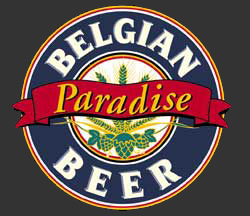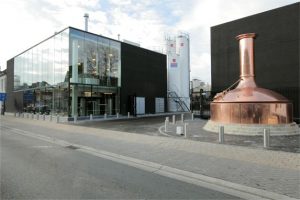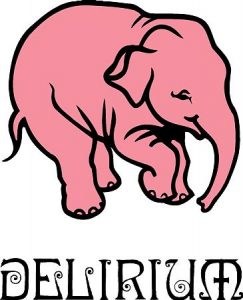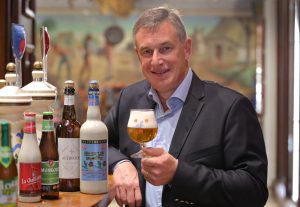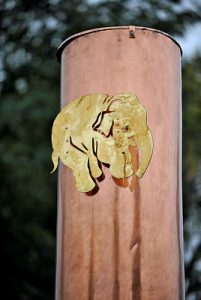Delirium’s History
This year’s Festival Featured brewery is Brouwerij Huyghe also known as Delirium for their signature line of pink elephant logo’ed beers.
The Story of Brewery Huyghe and Delirium
In 1902 a man named Leon Huyghe begins working at Den Appel Brewery in Melle, Belgium. Den Appel has existed in Melle since 1654, and over its history has become ‘The Brewery’ of Melle. Within four years of his start, Leon has married Delfina Van Doorselaer, a brewer’s daughter from Wolvertem, and taken over ownership of Den Appel Brewery. These were the formative years before Brouwerij Huyghe existed that were the catalyst for is future success. Shortly after Leon takes over Den Appel the first world war begins, and he is forced to close the Brewery’s Malt Works to keep the brewery afloat. This difficult yet tactful decision spares Den Appel the fate of shutting their doors that nearly half of Belgian breweries experience over the years of occupation and war to come.
In 1925 Leon’s son Albert, and son in-law Louis begin working at Den Appel. Over the next decade, the brewery flourishes and a ‘new’ brewery is opened on the edge of Melle bearing the family name, Brouwerij Huyghe. The facility’s imposing facade is built in industrial art deco style and is reminiscent of pre-war cinemas. The copper brewhouse is inaugurated and is fortunate enough to survive the Second World War and continues to be used up until 2012.
After the war, the brewery finds success with their Golden Kenia Pils, named after a French variety of Barley. The 60’s herald a golden age for Huyghe with the second generation of the family firmly at the helm. A new filling line is installed and Huyghe’s German Dort Style beer “Eigerbrau” becomes highly popular.
The 70’s however, bring a devastating recession to Belgium on the heels of the oil crisis. The last two breweries in nearby Ghent close and Brouwerij Huyghe is struggling. The struggle continues through the mid 80’s as the third generation takes ownership. Jean De Laet, Husband to Anny Huyghe (Alberts Daughter) purchases all the family member’s shares in the brewery, bringing sole ownership and keeping the brewery 100% within the family.
Luckily, Brouwerij Huyghe is soon adopted by nearby Ghent due to the vacuum of breweries in the city and Huyghe’s delicious “Artevelde City Beer”, the label of which depicts the facade of the Great Beguine of Ghent’s residence. At this time the brewery also begins to evolve from a pils focused brewery to a specialty beer brewery. Artevelde Cran Cru is the first bottle-fermented beer the brewery produces and is a sign of great things to come. More bottle fermented beers in varying styles are developed due to demand from new opportunities in Belgium and interest from export markets. Jean, a salesman at heart, develops over 250 corporate accounts across Belgium during the mid-80’s. Volumes are up and the export market is in its infancy.
In 1988 an Italian beer importer approaches Jean with a request. He urges Jean to develop a strong blond beer exclusively for the Italian market. Jean sets the Brewer’s to the task and a full-bodied yet balanced beer with yeasty impressions of banana and a hint of alcohol is born. The Italians are enamored from the first sip and ‘San Gregory’ beer bursts onto the sean. A year later, the tax and excise inspectors visit the brewery and are offered a sample of this special export beer. Immediately, one inspector suggests the beer should be introduced to Belgium. Yet, it doesn’t have a proper name for the market. The inspector idly comments “If I drink a lot of this, I will have a Delirium”, and suddenly the beer has a name.
Jean has never been one to avoid controversy. Launching a beer with a name that evokes the symptoms of a disease and alludes to alcoholic intoxication is just one instance of this. Jean continues to push the boundaries with Delirium by filling some very unique spare bottles that a German customer fell short on ordering. The bottles were painted gray with what was known as the “Cologne Pottery” motif. The appearance is bold and eye-catching, to say the least. In Jean’s mind, it needs a label just as unique to match the bold beer and bottle. A local art student who works part-time at the brewery is charged with developing the label. Imagery befitting the name “Delirium” is hand drawn, and soon pink elephants, dragons, crocodiles, and birds adorn the bottles representing the hallucinations one may encounter when in a state of Delirium. The unique bottles and animal illustrations are still employed to this day and have become iconic to beer lovers around the world.
Jean’s son, Alain joins the brewery in earnest in the early nineties. Alain had recently graduated with a degree in law and had spent his youth in and around the brewery. The combination brings a unique perspective that Jean quickly recognizes and supports. Alain is constantly brooding over new opportunities and strategies to expand the brewery. He sets about learning every facet of brewing and the unique complexities of Brouwerij Huyghe. Before long Jean puts Alain in charge of production and the next generation of the family has taken its place.
Alain De Leat current generation’s head of this multi-generation Belgian family brewer.
The ensuing decades see a litany of investments, expansions, and awards for the Brewery. The export markets grow, and Delirium rapidly becomes one of the most sought-after Belgian export beers. In 1997 American beer expert Stuart A. Kallen declares Delirium Tremens ‘The Best Beer in the World’ and beer lovers everywhere take notice.
2012 marks another milestone for Brouwerij Huyghe and Delirium. With eyes to the demands of the future, a new brewhouse capable of producing 350,000 hectolitres annually is installed along with numerous expansions to the facility. The state-of-the-art upgrade allows for streamlined production and a renewed focus on quality control and product development. It also leads to a 10% reduction in raw ingredients used, 30% less water used, and 50% less energy used, setting Brouwerij Huyghe on track to become the greenest brewery in Belgium. Sustainability and an environmentally conscious approach to producing beer continue to drive decision making at the brewery to this day.
Pictures from the brewery:
It is copper, copper, everywhere in this brewery except where it is also the most modern stainless steel. Old world and new world methods come together in one place.
